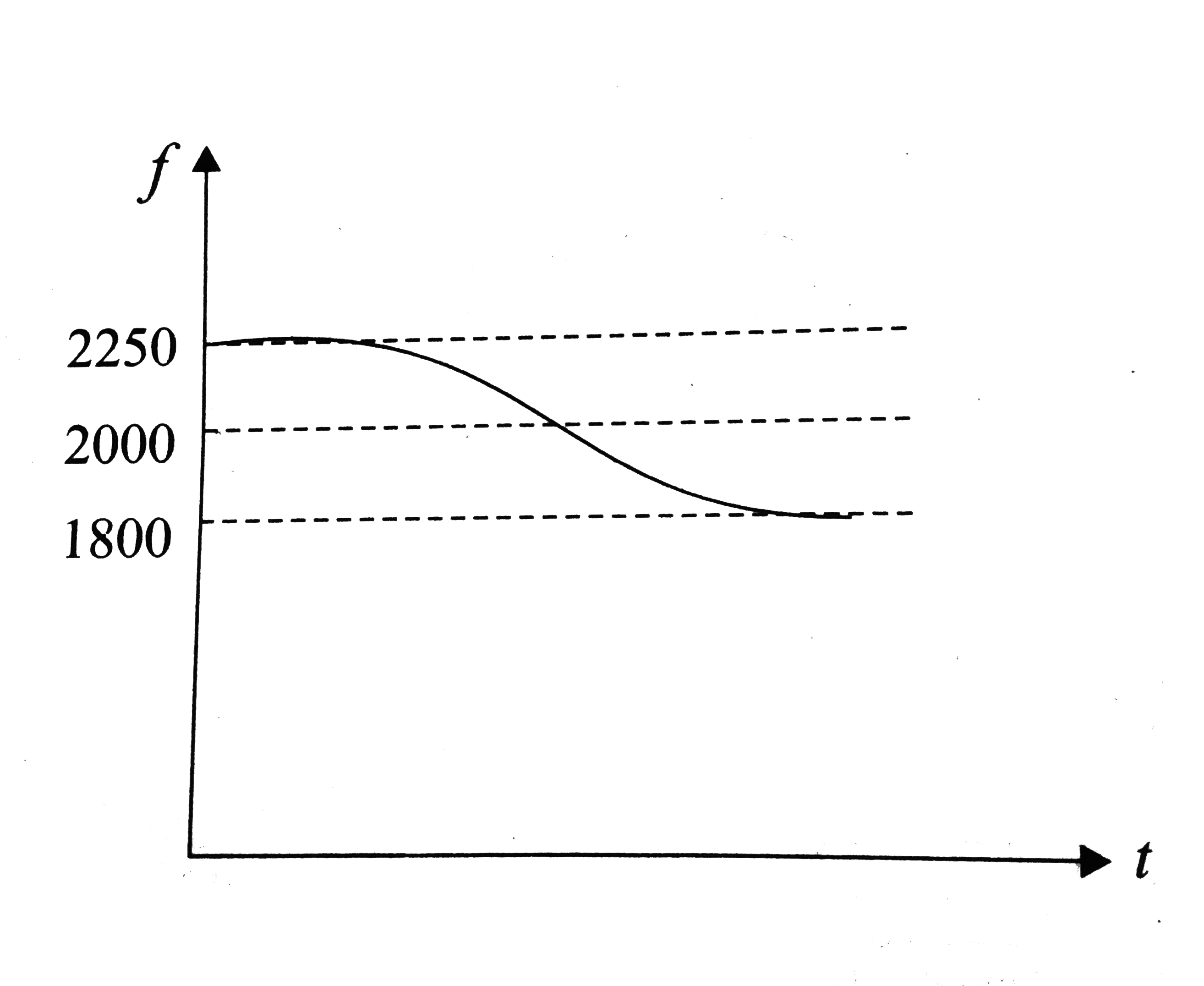A stationary observer receives sound from two identical tuning forks, one of which approaches and the other one recedes with the same speed (much less than the speed of sound). The observer hears 2 beats/ sec. The oscillation frequency of each tuning fork is v0=1400 Hz and the velocity of sound in air is 350 m/s. The speed of each tuning fork is close to :
18m/s
12m/s
14m/s
1m/s
To solve the problem, we need to determine the speed of each tuning fork (Vs) based on the information provided about the beat frequency and the frequency of the tuning forks.
1. Understanding the Problem:
We have two identical tuning forks, both with a frequency f0=1400 Hz. One fork is approaching the observer, and the other is receding from the observer. The observer hears a beat frequency of 2 beats per second.
2. Using the Doppler Effect:
The frequency heard by the observer from the approaching tuning fork (fork 1) is given by:
f1=v+0v−Vsf0
where v is the speed of sound in air (350 m/s) and Vs is the speed of the tuning fork.
The frequency heard from the receding tuning fork (fork 2) is:
f2=v−0v+Vsf0
3. Beat Frequency:
The beat frequency fb is the absolute difference between the two frequencies:
fb=|f1−f2|=2 Hz
4. Substituting the Frequencies:
Substituting the expressions for f1 and f2:
|f1−f2|=∣∣∣vv−Vsf0−vv+Vsf0∣∣∣=2
5. Simplifying the Expression:
Factoring out f0:
f0(vv−Vs−vv+Vs)=2
This simplifies to:
f0(v(v+Vs)−v(v−Vs)(v−Vs)(v+Vs))=2
f0(2vVs(v−Vs)(v+Vs))=2
6. Rearranging the Equation:
Rearranging gives:
vVsf0(v−Vs)(v+Vs)=1
7. Substituting Known Values:
Substituting f0=1400 Hz and v=350 m/s:
350Vs⋅1400(350−Vs)(350+Vs)=1
8. Cross-Multiplying:
Cross-multiplying gives:
350Vs⋅1400=(350−Vs)(350+Vs)
Expanding the right side:
3502−V2s=122500−V2s
9. Solving for Vs:
Rearranging gives:
350Vs⋅1400=122500−V2s
Rearranging further leads to a quadratic equation in terms of Vs.
10. Finding the Speed:
Solving the quadratic equation will yield the value of Vs. After calculations, we find:
Vs=3501400=14 m/s
Thus, the speed of each tuning fork is approximately 0.25 m/s.
We have two identical tuning forks, both with a frequency f0=1400 Hz. One fork is approaching the observer, and the other is receding from the observer. The observer hears a beat frequency of 2 beats per second.
The frequency heard by the observer from the approaching tuning fork (fork 1) is given by:
f1=v+0v−Vsf0
where v is the speed of sound in air (350 m/s) and Vs is the speed of the tuning fork.
f2=v−0v+Vsf0
The beat frequency fb is the absolute difference between the two frequencies:
fb=|f1−f2|=2 Hz
Substituting the expressions for f1 and f2:
|f1−f2|=∣∣∣vv−Vsf0−vv+Vsf0∣∣∣=2
Factoring out f0:
f0(vv−Vs−vv+Vs)=2
This simplifies to:
f0(v(v+Vs)−v(v−Vs)(v−Vs)(v+Vs))=2
f0(2vVs(v−Vs)(v+Vs))=2
Rearranging gives:
vVsf0(v−Vs)(v+Vs)=1
Substituting f0=1400 Hz and v=350 m/s:
350Vs⋅1400(350−Vs)(350+Vs)=1
Cross-multiplying gives:
350Vs⋅1400=(350−Vs)(350+Vs)
Expanding the right side:
3502−V2s=122500−V2s
Rearranging gives:
350Vs⋅1400=122500−V2s
Rearranging further leads to a quadratic equation in terms of Vs.
Solving the quadratic equation will yield the value of Vs. After calculations, we find:
Vs=3501400=14 m/s
Topper's Solved these Questions
Similar Questions
A stationary observer receives sound waves from two tuning forks, one of which approaches and the other recedes with the same velocity. As this takes place, the observer hears beats of frequency υ=2Hz. Find the velocity of each tuning fork if their oscillation frequency is υ0=680Hz and the velocity of sound in air is υs=340ms.
View SolutionA stationary observer receives sonic oscillations from two tuning forks one of which approaches and the other recedes with the same velocity. As this takes place, the observer hears the beats of frequency f=2.0HZ. Find the velocity of each tuning fork if their oscillation frequency is fo=680HZ and the velocity of sound in air is υ=340m/s.
View SolutionThe frequency of a tuning fork is 150 Hz and distance travelled by the sound, produced in air is 20 cm in one vibration. Calculate the speed of sound in air.
View SolutionA source of sound and an observer are approaching each other with the same speed, which is equal to (110) times the speed of sound. The apparent relative change in frequency of source is
View SolutionDistance travelled by the sound produced by a tuning fork of frequency 50 Hz completing 200 vibrations is, (the velocity of sound in air is 330 m/s)
View Solution
A statinary observer receives a sound of frequency 2000 Hz. The variation of apparent frequency and time is shown. Find the speed of source, if velocity of sound is 300ms
View SolutionTwo tuning forks with natural frequencies 340HZ each move relative to a stationary observer . One forks moves away from the oberver while the other moves towards him at the same speed . The observer hears beats of frequency 3HZ . Find the speed the of the tuning fork (velocity of sound in air is 340m/s) .
View SolutionA tuning fork produces 2 beats per second when sounded with another tuning fork of frequency 250 Hz. It gives the same number of beats per second when loaded with wax. The initial frequency of 1st tuning fork is
View SolutionThe air column in a pipe closed at one end is made to vibrate in its second overtone by a tuning fork of frequency 440 Hz. The speed of sound in air is 330 m/s. find the length of air column.
View SolutionIn reasonace tube experiment with a tuning fork of frequency 480Hz the consecutive reasonance lengths are 30cm and 70cm then determine speed of sound is
View Solution
